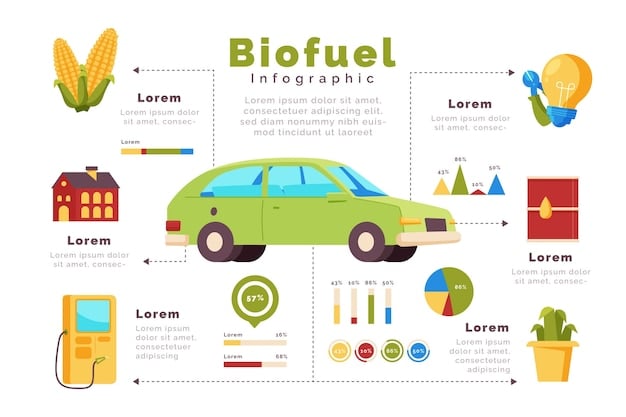Car Buying Guide 2025: Fuel Efficiency Standards Impact

Car Buying Guide 2025 focuses on navigating the evolving landscape shaped by new federal fuel efficiency standards, impacting vehicle choices and long-term ownership costs for consumers in the US.
Navigating the car buying guide 2025: understanding the impact of new federal fuel efficiency standards can seem daunting, but with the right information, you can make an informed decision that saves you money and benefits the environment.
Embracing the Future: New Federal Fuel Efficiency Standards
As the automotive industry races towards a more sustainable future, the federal government is implementing stricter fuel efficiency standards. These regulations will significantly impact the types of vehicles available and how they perform. Understanding these changes is crucial for making informed purchasing decisions in 2025.
These standards aim to reduce greenhouse gas emissions and improve fuel economy across the vehicle fleet. This means manufacturers are investing heavily in electric vehicles (EVs), hybrids, and more efficient gasoline engines. Consumers will benefit from these advancements through lower fuel costs and reduced environmental impact.
Understanding CAFE Standards
The Corporate Average Fuel Economy (CAFE) standards are a key component of federal fuel efficiency regulations. These standards set targets for the average fuel economy of a manufacturer’s entire fleet of vehicles.
Impact on Car Manufacturers
Automakers are responding to CAFE standards by investing in new technologies and vehicle designs. This includes developing more fuel-efficient engines, improving aerodynamics, and increasing the production of hybrid and electric vehicles.
- Investing in electric vehicle technology.
- Improving the fuel economy of gasoline engines.
- Developing hybrid powertrains.
- Reducing vehicle weight through advanced materials.
These new federal fuel efficiency standards are set to reshape the automotive market, pushing manufacturers to innovate and consumers to adapt. By understanding CAFE standards and their implications, both automakers and car buyers can navigate this evolving landscape effectively.

Electric Vehicles (EVs): The Rising Stars
Electric vehicles are rapidly gaining popularity, driven by technological advancements and increasing consumer awareness. With the new fuel efficiency standards, EVs are poised to become even more mainstream.
These vehicles offer zero tailpipe emissions, contributing to cleaner air and a reduced carbon footprint. Additionally, advancements in battery technology are extending the range of EVs, making them a practical option for more drivers.
Benefits of EVs
Electric vehicles offer numerous advantages over traditional gasoline-powered cars. These benefits include lower running costs, reduced maintenance, and a quieter driving experience.
Challenges of EV Ownership
Despite their benefits, EVs also face some challenges. These include higher upfront costs, limited range compared to gasoline cars, and the availability of charging infrastructure.
- Higher initial purchase price.
- Limited driving range.
- Availability of charging stations.
- Battery replacement costs.
Despite these challenges, the adoption of EVs is accelerating, and they are becoming an increasingly viable option for many consumers. As technology improves and infrastructure expands, EVs will play a crucial role in meeting the demands of the new fuel efficiency standards.
Hybrid Vehicles: Bridging the Gap
Hybrid vehicles offer a balance between traditional gasoline engines and electric power. These vehicles combine the benefits of both technologies, providing improved fuel economy and reduced emissions.
Hybrids use regenerative braking to capture energy during deceleration, which is then used to recharge the battery. This helps to improve fuel efficiency, especially in city driving.

Types of Hybrid Vehicles
There are several types of hybrid vehicles, including mild hybrids, full hybrids, and plug-in hybrids. Each type offers different levels of electrification and fuel efficiency.
Advantages of Hybrid Technology
Hybrid technology provides numerous benefits, including improved fuel economy, reduced emissions, and a smoother driving experience compared to traditional gasoline cars.
- Better fuel economy than gasoline cars.
- Lower emissions compared to gasoline cars.
- Regenerative braking system.
- Reduced reliance on gasoline.
Hybrid vehicles represent a practical and efficient option for consumers looking to reduce their environmental impact without fully committing to an EV. They offer a balance of performance, fuel economy, and convenience.
Gasoline Engines: Efficiency Refinements
While electric and hybrid vehicles are gaining traction, gasoline engines are still a major part of the automotive landscape. Automakers are working to improve the fuel efficiency of these engines to meet the new standards.
Advancements in engine technology, such as direct injection, turbocharging, and variable valve timing, are helping to improve fuel economy and reduce emissions. These innovations are making gasoline engines more efficient than ever before.
Advancements in Gasoline Engine Technology
Several key technologies are contributing to the improved fuel efficiency of gasoline engines. These include direct injection, turbocharging, and variable valve timing.
Optimizing Aerodynamics and Weight Reduction
In addition to engine improvements, automakers are also focusing on aerodynamics and weight reduction to improve fuel efficiency. Streamlined designs and lightweight materials help to reduce drag and improve overall performance.
- Direct injection for precise fuel delivery.
- Turbocharging for increased power and efficiency.
- Variable valve timing for optimized engine performance.
- Use of lightweight materials like aluminum and carbon fiber.
Gasoline engines remain a viable option for many consumers, and ongoing advancements in technology are making them more efficient and environmentally friendly. These improvements are crucial for meeting the new fuel efficiency standards.
Navigating Car Buying in 2025: Practical Tips
With the new fuel efficiency standards in place, buying a car in 2025 requires a strategic approach. Understanding your needs, researching different vehicle options, and considering long-term costs are essential.
Start by assessing your daily driving needs and habits. Consider factors such as commute distance, passenger capacity, and cargo space. This will help you narrow down your options and focus on vehicles that meet your specific requirements.
Researching Different Vehicle Options
Take the time to research different vehicle options, including electric, hybrid, and gasoline models. Compare fuel economy ratings, performance specifications, and safety features.
Considering Long-Term Costs
In addition to the initial purchase price, consider the long-term costs of ownership, such as fuel, maintenance, and insurance. Electric vehicles may have higher upfront costs but lower running costs due to cheaper electricity compared to gasoline.
- Evaluate your driving needs (commute, passengers, cargo).
- Research fuel economy ratings and performance.
- Consider long-term ownership costs (fuel, maintenance, insurance).
- Explore government incentives and tax credits.
By following these practical tips, you can navigate the car buying process in 2025 with confidence and make an informed decision that aligns with your needs and budget.
Government Incentives and Tax Credits
To encourage the adoption of fuel-efficient vehicles, the government offers various incentives and tax credits. These programs can help to offset the higher upfront costs of electric and hybrid vehicles.
These incentives can significantly reduce the overall cost of ownership, making them an attractive option for consumers. It’s important to research available incentives and credits to maximize your savings.
Federal Tax Credits for Electric Vehicles
The federal government offers tax credits for the purchase of new electric vehicles. The amount of the credit varies depending on the vehicle’s battery capacity and other factors.
State and Local Incentives
In addition to federal incentives, many state and local governments offer their own programs to promote the use of fuel-efficient vehicles. These incentives may include rebates, tax credits, and emissions exemptions.
- Federal tax credits for EVs.
- State and local rebates for EVs and hybrids.
- HOV lane access for certain fuel-efficient vehicles.
- Emissions testing exemptions.
Government incentives and tax credits can make fuel-efficient vehicles more affordable and accessible. By taking advantage of these programs, consumers can save money and contribute to a more sustainable future.
The Future of Driving: Sustainable Choices
The automotive industry is undergoing a significant transformation, driven by the need for more sustainable transportation options. Electric, hybrid, and fuel-efficient gasoline vehicles are all playing a role in this evolution.
As technology continues to advance and infrastructure expands, electric and hybrid vehicles will become even more prevalent. Consumers who embrace these changes and make informed choices can contribute to a greener future.
The Role of Renewable Energy
The integration of renewable energy sources, such as solar and wind power, is essential for maximizing the environmental benefits of electric vehicles. Charging EVs with clean energy helps to reduce the carbon footprint of transportation.
The Importance of Sustainable Manufacturing
In addition to fuel efficiency, sustainable manufacturing practices are becoming increasingly important. Automakers are working to reduce waste, conserve resources, and minimize the environmental impact of their operations.
- Adoption of renewable energy sources for EV charging.
- Sustainable manufacturing practices in the automotive industry.
- Development of advanced battery technologies.
- Continued innovation in fuel-efficient gasoline engines.
The future of driving is sustainable, and by making informed choices and supporting innovative technologies, consumers can play a crucial role in shaping a greener and more efficient transportation system.
| Key Aspect | Brief Description |
|---|---|
| 🌱 Fuel Efficiency Standards | New regulations impacting vehicle design and fuel economy. |
| ⚡️ Electric Vehicles | Zero tailpipe emissions and advancements in battery tech. |
| 🚗 Hybrid Vehicles | Balance of gasoline and electric power for improved fuel economy. |
| 💰 Government Incentives | Tax credits and rebates to encourage eco-friendly vehicle adoption. |
FAQ
▼
The new standards aim to increase the average fuel economy of vehicles sold in the US, reducing greenhouse gas emissions and promoting more sustainable transportation.
▼
Car manufacturers must invest in new technologies, like EVs and hybrids, to meet the standards. This drives innovation and a shift toward cleaner vehicle options.
▼
Electric vehicles offer zero tailpipe emissions, lower running costs, and reduced maintenance. They also provide a quieter and smoother driving experience.
▼
Yes, both federal and state governments offer tax credits, rebates, and other incentives to encourage the purchase of electric and hybrid vehicles.
▼
Assess your driving needs, research different vehicle options, and consider long-term ownership costs. Explore electric, hybrid, and fuel-efficient gasoline models to find the best fit.
Conclusion
As you prepare to navigate the car buying guide 2025: understanding the impact of new federal fuel efficiency standards, remember that informed decisions are key. By understanding the changing landscape, exploring different vehicle options, and taking advantage of available incentives, you can make a purchase that benefits both your wallet and the environment.





